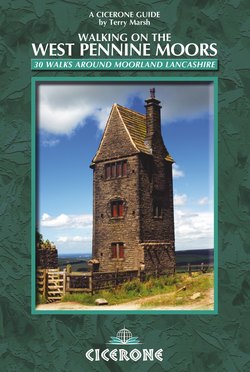Читать книгу Walking on the West Pennine Moors - Terry Marsh - Страница 15
На сайте Литреса книга снята с продажи.
ОглавлениеWALK 5
Rivington Country Park
| Start/Finish | Car park, opposite Horwich and Blackrod High School (SD634128) |
| Distance | 5.5km (3.4 miles) |
| Height gain | 96m (315ft) |
| Terrain | Stony paths and graded tracks |
The seemingly innocuous hills and moors of Rivington Country Park nevertheless proved demanding enough to host the 2002 Commonwealth Games outdoor cycling events. This tour of the park is largely confined to the former estates of Lord Leverhulme, visiting the replica of Liverpool Castle ruins, and two outstanding cruck barns of some antiquity. On the way, we also pass Rivington Hall, sometime home of Lord Leverhulme, whose influence was considerable both here in Lancashire and much further afield.
The walk begins from a car park just off the Rivington road, opposite Horwich and Blackrod High School. From the rear of the car park, set off along a broad path through light woodland. Ignore any diverging pathways, and press on to walk parallel with a much broader, stony track on your right. Do not join this track – just stay parallel with it for about 80m, and then climb briefly to the left, to walk alongside a wooden fence, later becoming a fence of tall iron railings.
Just after Lower Rivington Reservoir comes into view, pass through a gap in the railings and bear left, down towards the waterline and then along the water’s edge. When the path rises sharply, climb with it to reach the walls of Liverpool Castle. Go round to the front of the castle to gain access and explore this unusual edifice, but then return to the stony path to continue the walk.
The original Liverpool Castle was probably built in the 13th century under the orders of William de Ferrers (c1168–c1247), the Fourth Earl of Derby, and a favourite of King John (1199–1216). The castle was built to protect King John’s new port of Liverpool, and was sited at the top of present-day Lord Street, the highest point in the city and overlooking the Pool. The castle was built on top of a plateau, which had been specially constructed, and a moat around it was carved from solid rock. Here at Rivington you see a full-size replica, built in the early 1900s for the First Viscount Leverhulme, and based on a partly conjectural reconstruction of the castle prepared by EW Cox in 1890. In effect, this is a replica of a ruin, not a ruin of a replica, although it was never fully completed, funds drying up on the death of Lord Leverhulme.
Liverpool Castle
The route continues through woodland, predominantly of beech and sycamore. Eventually, the path moves away from the reservoir, and once more runs alongside a wooden fence, now with Rivington Pike in view ahead.
By following the fence as it loops around a conservation area, you come to a fork in the track. Here, one option swings off in a wide curve to the right, and the other, the way to go, bears left, still with a fence alongside, and now with intermittent red waymark arrows. The path soon returns to the edge of the reservoir.
Stay alongside the fence as it once more turns away from the reservoir, and passes through a pronounced dip. On the other side of the dip, stay with the fence for a little longer, but only until you can bear right (at the first fork) on a clear, stony path that leads into the edge of the car park at Great House Barn. Walk up the surfaced lane to the left of the barn.
During 2008, a ‘Go Ape’ attraction was built here, in spite of local opposition.
